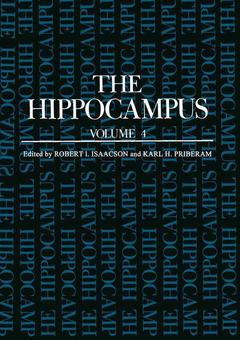The Hippocampus, Softcover reprint of the original 1st ed. 1986 Volume 4
Langue : Anglais
Coordonnateurs : Isaacson R.L., Pribram K.H.

The current volumes of The Hippocampus reflect the prodigious amount of work aimed at discovering the functions of this structure over the past decade. The hippocampus ideally lends itself to two types of study: (1) because of its regular and relatively simple cytoarchitecture, it can serve as a model for cortical processing in general, and (2) because of its size and central location, the role of the hippocampus in the total ecology of brain function poses an important challenge. We attempted to divide the contributions to Volumes 3 and 4 according to these two types of experimental aims. As always, however, when one makes dichotomies, one finds them inadequate in treating certain data and our attempt is no exception. There are contributions that do not fit the classification and there are others which fit both. In addition, there are manuscripts which we wanted to include but which the authors were not ready to submit at this time. Larry Squire, Mortimer Mishkin, and others are making important contributions which donot appear in these volumes except among references throughout. But this was also the case for Volumes 1 and 2 where we sorely miss the irreplaceable contributions of James Olds, Ross Adey, and Brenda Milner. Volume 4 is concerned primarily with the role of the hippocampus in the ecology of the brain in regulating behavior and experience. The contri butions have the potential to raise the level of our understanding considerably.
1. An Executive Function of the Hippocampus: Pathway Selection for Thalamic Neuronal Significance Code.- 1. Introduction.- 2. Methods: Discrete Lesions and Recording of Unit Activity during Discriminative Avoidance Behavior.- 3. A Working Model for Limbic Telodiencephalic Function.- 4. Supporting Data.- 5. Implications for Human Memory Mechanisms.- 6. References.- 2. Brainstem Modulations of the Hippocampus: Anatomy, Physiology, and Significance.- 1. Introduction.- 2. Mechanisms of Theta Generation within the Hippocampus.- 3. The Cholinergic Septohippocampal Theta-Generating System.- 4. Brainstem Systems Controlling the Hippocampal EEG.- 5. Unit Activity of Brainstem Nuclei Implicated in the Generation of the Theta Rhythm.- 6. Ascending Brainstem-to-Septohippocampal Pathways Involved in the Control of the Hippocampal EEG.- 7. Significance of the Hippocampal Theta Rhythm.- 8. General Summary and Conclusions.- 9. References.- 3. Behaviorally Dependent Neuronal Gating in the Hippocampus.- 1. Neuronal Gating.- 2. Brainstem Influences on Neuronal Gating.- 3. Discussion.- 4. References.- 4. Selective Hippocampal Lesions and Behavior: Implications for Current Research and Theorizing.- 1. Introduction.- 2. Neuroanatomical Considerations.- 3. Early Research Using Lesions Limited to Hippocampal Subregions.- 4. The Use of Neurotoxins to Selectively Lesion the Hippocampus.- 5. Behavioral Effects of Selective Neurotoxin Lesions.- 6. Implications for Theories of Hippocampal Function and Current Research in the Area.- 7. Summary and Conclusions.- 8. References.- 5. Cholinergic and Catecholaminergic Modification of the Hippocampal Lesion Syndrome.- 1. Early Attempts to Alleviate the Behavioral Impairments by External Manipulations.- 2. Secondary Neurochemical Changes Following Hippocampal Damage.- 3. Cholinergie Manipulations and Hippocampal Lesion Effects.- 4. Glucocorticoid Changes and Hippocampal Lesion Effects.- 5. An Analysis of Hippocampal Effects in the Open Field.- 6. Spontaneous Alternation.- 7. Conclusions.- 8. References.- 6. Comparator and Buffer Memory: An Attempt to Integrate Two Models of Hippocampal Function.- 1. The Hippocampus as a Comparator.- 2. The Hippocampus as a Memory Buffer.- 3. Relationship between the Models.- 4. Antianxiety Drugs and the Septhohippocampal System.- 5. Conclusions.- 6. References.- 7. Role of the Hippocampus in Classical Conditioning of Aversive and Appetitive Behaviors.- 1. Introduction.- 2. Hippocampal Unit Activity during Classical Conditioning of the NM and CJM Responses.- 3. Intrinsic Changes in the Hippocampus as a Result of Classical Conditioning: Evidence and Potential Mechanisms.- 4. Relationship between Hippocampal Neuronal Activity and Learned Behavior 22..- 5. Multisynaptic Anatomical Pathways Underlying the Behavioral Consequences of Hippocampal Neuronal Plasticity.- 6. Summary.- 7. References.- 8. The Monkey and the Sea Horse.- 1. Introduction.- 2. Behavioral Profile of Adult Monkeys with Damage to the Hippocampal System.- 3. Effects of Hippocampal Damage as a Function of Age of Lesion.- 4. Associative Learning Spared, Recognition and Associative Memory Not Spared, after Early Ablations of Hippocampus.- 5. Summary and Comments.- 6. Conclusions.- 7. References.- 9. Hippocampal Function and Memory for Temporal Context.- 1. Introduction.- 2. Comparative Cognition.- 3. Memory for the Temporal Context of an Event.- 4. Animal Tests of Working and Reference Memory.- 5. Memory for Temporal Intervals.- 6. Conclusions.- 7. References.- 10. Memory for Unique Instances: Temporal Lobe and Hippocampal Dependence.- 1. The Working Memory Model of Temporal Lobe Deficits.- 2. A New Animal Model of Temporal Lobe Memory Deficits.- 3. A Test of the Model.- 4. Application of the Model to Cognitive Place Learning.- 5. The Value of Unique Instance Memories.- 6. Evaluation of the Model.- 7. Conclusions.- 8. References.- 11. The Hippocampal System and Recombinant Processing.- 1. Introduction.- 2. Limbic versus Nonlimbic Learning and Memory.- 3. Hippocampus versus Amygdala: Novelty and Familiarity.- 4. The Hippocampus and Competence.- 5. Whither Now?.- 6. References.
Date de parution : 03-2012
Ouvrage de 398 p.
17.8x25.4 cm
Thème de The Hippocampus :
Mots-clés :
Manuscript; anatomy; architecture; brain; brainstem; classification; cognition; cortex; electroencephalography (EEG); experiment; neurons; neuropathology; physiology; time
© 2024 LAVOISIER S.A.S.



